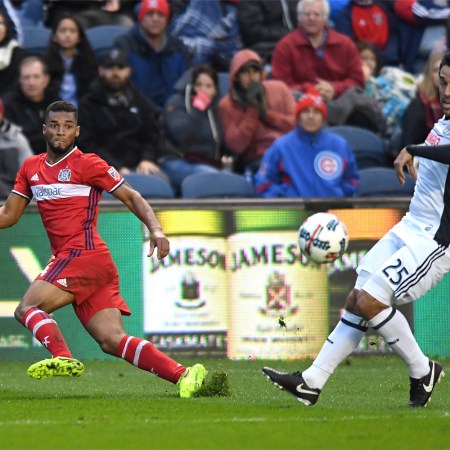On the first gameday of the 2015 Barclays Premier League season, Arsenal center forward Olivier Giroud and West Ham United center half James Tomkins clashed heads.
Violently.
Giroud, back squared to Tomkins’s chest, had risen to meet a lofted free kick in the 18-yard box in the 74th minute. Tomkins rose with him. When both players snapped their necks at the ball, their heads met in the middle. A second later, both were supine at the goalie’s feet, Giroud briefly grasping at the air in what appeared to be a classic fencing response, Tomkins doubled over in a fetal hunch. Play was stopped immediately.
Now, had this been an NFL game, it is unlikely either player would have returned.
On this day, however, Giroud and Tomkins were almost immediately declared able to play. Giroud looked especially dazed upon his return to action; both finished the game. A week of finger-wagging from all corners of the media followed, but as has been the case with countless other high-profile head injuries in recent years, no action was taken by England’s FA.
Which begs the question: why, given the highly-publicized campaign to establish more rigorous concussion protocols across America’s sporting landscape in recent years, hasn’t club soccer followed suit?
Theoretically, it has. FIFA rules stipulate that any player exhibiting concussion symptoms and/or unconsciousness in a game should be withdrawn immediately and barred from further action for at least five days.
But in practice, managers, players and medical staff tend to ignore that rule. The reason is twofold. Crucially, players are assessed by their own team’s medical staff. Medical staff who are on the team’s payroll. Medical staff who have a vested interest in the team winning. Medical staff who are sometimes berated by the manager if he does not agree with their course of action.
Second, soccer allows for only three substitutions per game. That makes a substitution in soccer incredibly valuable. The importance of using a substitution to replace a concussed player can be — at least in a manager’s eyes — subordinate to using that substitution strategically.
Sports media has been vocal on both fronts in recent years, calling for the sport’s governing bodies to A) take these decisions out of the hands of team-employed medical staff and B) allow a fourth substitution when a player suffers a concussion. As with many bureaucracies, these calls for change have fallen on deaf ears. Above all, there is a persistent (and entirely plausible) fear that teams would exploit a fourth substitute; that they would, in essence, instruct players to fake concussions in order to bring on a new player.
At this point, a tragedy seems imminent, and perhaps the only harbinger for change.
Elite athletes will never willingly remove themselves from the field if they are physically able to continue (whether a concussed player even has the cognitive capacity to make that declaration is a different question). This is hardwired. Ruggedness, perseverance, “playing through pain” — these are all qualities intrinsic to the highest level of sport. But every time a concussed soccer player returns to the field of play, he is one headed ball or clash of heads away from second impact syndrome, a potentially fatal injury.
Will it take a career — or worse, life — threatening injury for the sport to change its tune?
This article was featured in the InsideHook newsletter. Sign up now.























